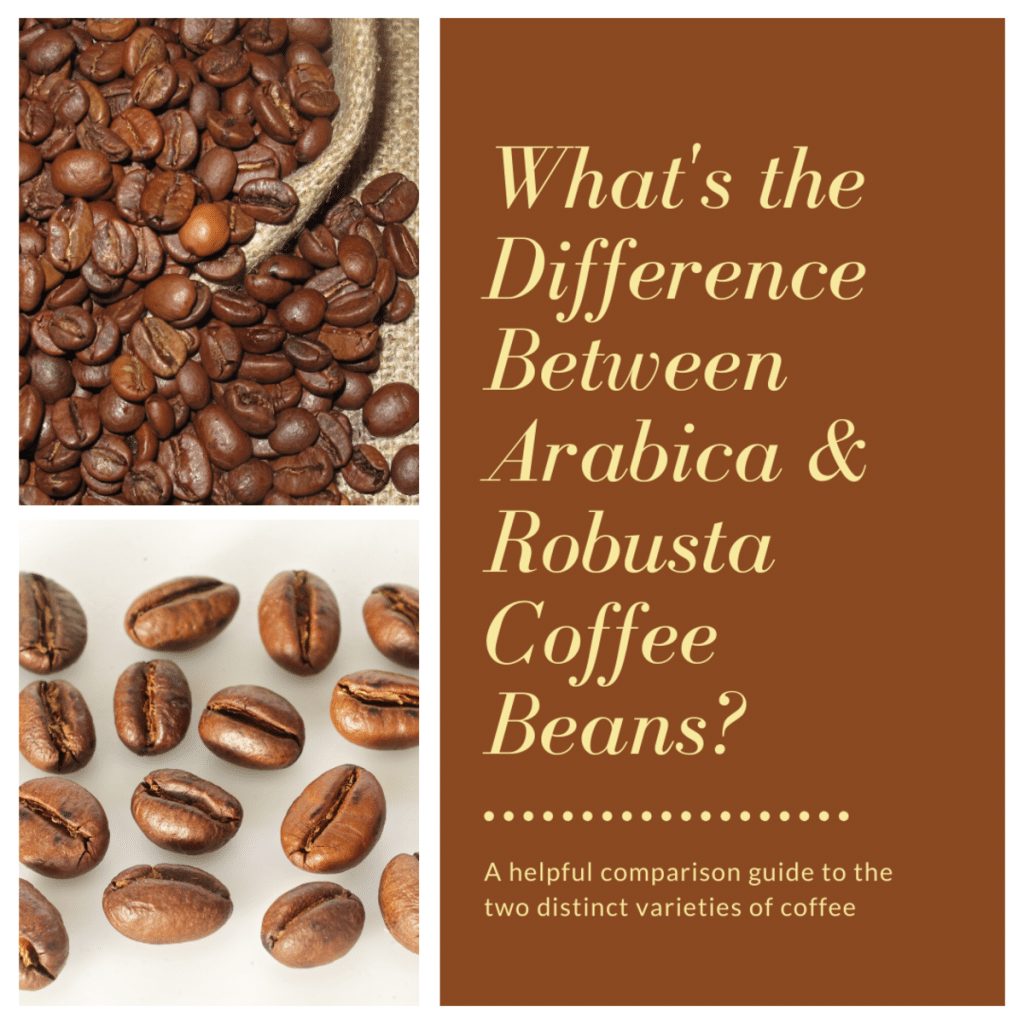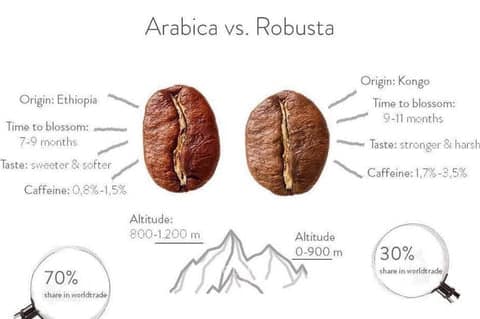Are you a coffee lover who is constantly amazed by the variety of flavors and aromas that different coffee beans offer?
If so, you may have come across the terms Arabica and Robusta while browsing through coffee menus or shopping for beans.
But what exactly sets these two types of coffee apart? In this article, we will explore the distinct characteristics of Arabica and Robusta coffee, shedding light on their flavor profiles, growing conditions, and overall popularity in coffee.
Whether you are a seasoned coffee connoisseur or someone who enjoys a good cup of joe, understanding the difference between Arabica and Robusta will take your coffee appreciation to the next level.
Taste
Arabica Coffee Taste
Arabica coffee is known for its delicate and complex flavor profile, making it the favorite choice among coffee connoisseurs.
The taste of Arabica coffee is often described as smooth, sweet, and with notes of chocolate, caramel, berries, and nuts. It has a lower acidity level than Robusta coffee, contributing to its mellow and well-balanced flavor. Arabica coffee is enjoyed by many for its refined taste and pleasant aftertaste.
Robusta Coffee Taste
On the other hand, Robusta coffee is known for its bold and intense flavor. It has a more robust and earthy taste compared to Arabica coffee.
Robusta coffee tends to have higher levels of bitterness and acidity, with hints of chocolate, burnt rubber, and even tobacco. The intense flavor of Robusta coffee makes it popular for those who prefer a more intense and robust cup of coffee.
Despite its strong flavor, it may lack Arabica coffee’s subtle nuances and complexity.
Aroma
Arabica Coffee Aroma
Arabica coffee is highly regarded for its delightful aroma, often described as floral, fruity, and even wine-like. The aroma of Arabica coffee is captivating, with hints of jasmine, berries, citrus, and sometimes even spices.
Arabica coffee’s fragrant and aromatic qualities contribute to the overall sensory experience and make it a delightful coffee to savor.
Robusta Coffee Aroma
Robusta coffee, in contrast, has a more intense and nutty aroma. The aroma of Robusta coffee is often described as woody or earthy, with hints of peanuts, dark chocolate, and spice.
Some may find the aroma of Robusta coffee slightly less appealing compared to the captivating aroma of Arabica coffee.
However, the strong and distinct aroma of Robusta coffee has charm and is preferred by those who enjoy a more robust sensory experience.
Caffeine Content
Arabica Coffee Caffeine Content
Regarding caffeine content, Arabica coffee typically contains less caffeine than Robusta coffee. On average, Arabica coffee beans have about 1.2% caffeine content.
The lower caffeine content in Arabica coffee contributes to its smoother and less bitter taste profile. Arabica coffee may be the preferred choice for individuals who are more sensitive to caffeine or prefer a milder cup of coffee.
Robusta Coffee Caffeine Content
Robusta coffee, on the other hand, is known for its higher caffeine content. On average, Robusta coffee beans contain about 2.2% caffeine content. The higher caffeine content in Robusta coffee gives it a strong and bold flavor.
It also contributes to the higher acidity and sometimes more bitter taste of Robusta coffee. Robusta Coffee might be the way to go if you’re looking for a more decisive caffeine kick or a bolder flavor profile.
Growing Conditions
Arabica Coffee Growing Conditions
Arabica coffee plants thrive in specific growing conditions. They prefer altitudes between 2,000 and 6,000 feet, with temperatures around 60 to 70°F.
Arabica coffee plants require a well-distributed rainfall of about 60 to 100 inches annually. These finicky plants are also sensitive to frost and require a frost-free environment. Additionally, Arabica coffee plants prefer shade and a loamy soil type.
Robusta Coffee Growing Conditions
Unlike Arabica coffee, Robusta coffee plants are more resilient and can grow in a broader range of altitudes and temperatures. Robusta coffee plants can withstand lower altitudes, ranging from near sea level to 2,000 feet.
They thrive in temperatures between 75 and 85°F. Robusta coffee plants require a higher annual rainfall of about 80 to 100 inches. They can also tolerate direct sunlight and can be grown in various soil types, including sandy or clayey soil.
Plant Characteristics
Arabica Coffee Plant Characteristics
Arabica coffee plants are known for their elegant appearance. They are tall, delicate trees with elongated leaves. The leaves have a glossy dark green color, making them aesthetically pleasing.
Arabica coffee plants generally have a slower growth rate than Robusta coffee plants. The slower growth contributes to the more extended maturation period of the coffee cherries, allowing for more complex flavors to develop.
Robusta Coffee Plant Characteristics
Robusta coffee plants, in contrast, are hardier and more robust. They have a more bush-like appearance and shorter stature than Arabica coffee plants. Robusta coffee plants have broad and round leaves that are often darker and veiny.
They have a faster growth rate, and their coffee cherries typically mature more quickly than Arabica coffee plants. The quicker maturation often results in a higher yield for Robusta coffee plants.
Yield
Arabica Coffee Yield
Regarding yield, Arabica coffee plants generally produce a smaller harvest than Robusta coffee plants. Arabica coffee plants have a lower yield due to their more delicate nature and vulnerable growing conditions.
A mature Arabica coffee plant typically produces around 5 to 7 pounds of coffee cherries yearly. However, the lower yield of Arabica coffee is often compensated by its superior quality.
Robusta Coffee Yield
Robusta coffee plants, on the other hand, are known for their higher yield. They are more productive and can thrive in a broader range of conditions. A mature Robusta coffee plant can produce around 10 to 15 pounds of coffee cherries annually.
The higher yield of Robusta coffee plants makes them a popular choice for commercial coffee production, as they can provide a more excellent supply of coffee beans.
Disease Resistance
Arabica Coffee Disease Resistance
One of the challenges with Arabica coffee plants is their susceptibility to diseases such as coffee leaf rust and coffee berry disease.
Arabica coffee plants are generally more prone to disease and require meticulous care and maintenance to prevent and manage these issues. However, advancements in agricultural practices and disease-resistant varieties of Arabica coffee have been developed to combat these challenges and improve their resistance.
Robusta Coffee Disease Resistance
Robusta coffee plants, on the other hand, are naturally more resistant to diseases compared to Arabica coffee plants. They have a higher tolerance for common coffee diseases, making them easier to grow and maintain.
Robusta coffee plants are specifically known for their resistance to coffee leaf rust. The natural disease resistance of Robusta coffee plants contributes to their higher yield potential and popularity in commercial coffee production.
Quality
Arabica Coffee Quality
Arabica coffee is widely recognized for its superior quality and is often considered the benchmark for specialty coffee. The delicate flavor profile, pleasant acidity, and captivating aroma of Arabica coffee contribute to its exceptional quality.
Arabica beans are hand-picked and undergo a meticulous process of harvesting, sorting, and roasting to preserve their quality and ensure a delightful coffee experience. Due to the higher demand and lower yield, Arabica coffee is often priced at a premium, reflecting its superior quality.
Robusta Coffee Quality
While Robusta coffee is generally regarded as having lower quality than Arabica coffee, it still has merits. Robusta coffee is known for its solid and robust flavor, making it a popular choice for espresso blends and instant coffee.
However, the higher bitterness and lower complexity of Robusta coffee can affect its overall quality perception.
Advances in cultivation, processing, and blending techniques have improved the quality of Robusta coffee in recent years, allowing for a better appreciation of its unique characteristics.
Price
Arabica Coffee Price
The price of Arabica coffee tends to be higher than Robusta coffee due to its superior quality and lower yield.
Arabica coffee requires specific growing conditions and meticulous care, resulting in higher production costs.
The limited supply and higher demand for Arabica coffee also contribute to its price tag. Coffee enthusiasts and specialty coffee shops are often willing to pay a premium for Arabica coffee’s exceptional taste and quality.
Robusta Coffee Price
The price of Robusta coffee is generally lower compared to Arabica coffee due to its higher yield and easier cultivation. Robusta coffee requires less maintenance and can be grown in a broader range of conditions, resulting in lower production costs.
The higher supply and lower demand for Robusta coffee contribute to its lower price than Arabica coffee. Robusta coffee is often utilized in blends and instant coffee, where affordability and a more robust flavor profile are prioritized.
Popular Uses
Arabica Coffee’s Popular Uses
Arabica coffee is widely used for various coffee brewing methods, including pour-over, French press, and espresso. Its delicate flavor profile and well-balanced acidity make it a favorite choice for those who appreciate the subtleties of a high-quality coffee.
Arabica coffee is often enjoyed in black to experience its distinct taste profile fully.
Additionally, Arabica coffee is used to make specialty coffee drinks, such as cappuccinos, lattes, and macchiatos, where its flavors can be enhanced or complemented by milk and other ingredients.
Robusta Coffee’s Popular Uses
With its bold and robust flavor, Robusta coffee is commonly used in espresso blends and instant coffee. Its higher caffeine content and intense taste suit those seeking a quick pick-me-up or a bolder coffee experience.
Robusta coffee can withstand the intense heat and pressure of espresso extraction, resulting in a fuller-bodied and more robust espresso shot.
It is also commonly used in the production of instant coffee due to its affordability and ability to retain its flavors during the drying and extraction process.










































